Don't wanna be here? Send us removal request.
Text
Cooking with Fannibals: Paratext, Textual Poaching and Hannibal fandom
In the current television environment, the perception of television contents for fans is not confined to the specific scene of the show. Owing to varieties of activities, it gradually reshaped and formed into a virtual community where fans could express their ideas, communicate with different members and even make contributions to. Sandvoss (2005) notes that ‘the study of fans and fandoms has formed one of the most proliferating areas of media and cultural studies in recent decades’. Due to the remarkably growing of fandom, fans participate with TV producers and showrunners more and more often by utilizing social media as platforms. They tend to be more creative and active by writing fan-fictions, producing parody, fan-act and creating memes, gifs. According to a report by Macklem (2013), it points out that two thirds of producers will take fan’s ideas into consideration, but only 9% have taken these suggestions into the show. On the other hand, Jenkins (1992) also states ‘fans lack direct access to the means of commercial cultural production and have only the most limited resources with which to influence the entertainment industry’s decisions.’ It is true to a certain extent that creators of show have aware of the importance of interacting with their fans. While others consider producers are still dominant to the show and decide where the show’s major direction is head to. Hence, this essay focuses on whether fandom has the power to influence the show. If so, to that extent? Firstly, a case study from NBC’s Hannibal will be described. Subsequently, two concepts named paratext and textual poaching which relate to the case study will be discussed. Moreover, a critical analysis of the case study will be given by applying the two core concepts as tools. To conclude, since the conflict between fans and producers is almost in every media fandom, reflection around whether it can find a balance between these two will be considered.
Pearson (2010) suggested that “the digital revolution has had a profound impact upon fandom, particularly as it blurs the lines between producers and consumers, creates relationships between powerful corporations and individual fans”. It could be considered that the 2013 TV show Hannibal is a perfect example to present the relationship between producers and fandom. The story of Hannibal Lecter was introduced in 1981 thriller novel Red Dragon by Thomas Harris, and developed in the following 3 books Silence of the Lamb (1988), Hannibal (1999) and Hannibal Rising (2006). This series of suspense novels attracted movie maker’s attention then turned into 5 movies which are Manhunter (1986), Silence of the Lambs (1991), Hannibal (2001), Red Dragon(2002) and Hannibal Rising (2007). It is generally recognized that the movie silence of the lamb has culturally, historically and aesthetically significance and won Academy Awards in Best Picture, Best Actor, Best Actress, Best Director, and Adapted Screenplay. While after a long period of time there was no adaptations of the Hannibal Lecter franchise due to the critics about the subsequent movies until in 2013 the American broadcast network NBC considered to ask Bryan Fuller to make a television series in order to reinterpret the Hannibal universe. The show tells a story about a FBI special agent Will Graham and a forensic psychiatrist Hannibal Lecter which set up before the Red Dragon events, took on new, unexplored adventures and referring to the original books at the same time (Andersen, 2016). The show has gain huge popularity among internet fandoms within two months and seems to reach the same enthusiasm which reserved for three current TV shows Supernatural, Doctor Who and Sherlock. It is evident that the success of the show not only rely on the elaborate production by the staff of the show, but also the way that creators interact with fans proactively. Therefore, paratext and textual poaching are two aspects to look into the relationship between producers and fans.

Paratext has been examined since 20th century and now is widespread in media industry. There are many different definitions of paratext, for example, Genette (2001) suggests an explanation for Paratext that it is materials such as author’s name, preface, the title, introduction, illustrations or even audience which accompany the text in a published work. It also indicates that it is “more than a boundary or a sealed border, the paratext is, rather, a threshold." It is reasonable believed that paratext could not stand on its own, but became a significant element in a triangular relationship between Text, Audience and Industry. In addition, Gray (2010) mentions that the theory of ‘The Big Three of media practice’ and as well points out that “Industry and audiences create vast amounts of paratexts. Audience also consume vast amounts of paratexts.” Next, during the history of participatory culture, it is interesting to see that the producers and fans were in a state of conflict. Backing to the 18th century, media sees “readers” as passive consumers who need to be informed by the “producers” of knowledge and communications media. De Certeau (1984) comments that “this legend is necessary for the system that distinguishes and privileges ‘producers’, in contrast with those who do not produce.” In addition, Jenkins (1992) further asserts that “fans must beg with the networks to keep their favorite shows on the air, must lobby producers to provide desired plot developments or protect the integrity of favourite characters. Within the cultural economy, fans are peasants, not proprietors”. For example, under the public pressure, Arthur Conan Doyle was forced to write The Adventure of the Empty House in order to bring Sherlock Holmes back to life. It is generally agreed that the fans were too obsessed to this character to let the character go, then strongly requested the author to continue his writing about this genius detective. When the digital age comes, due to the rapid development of internet, fans seem to be more interactive with shows than in the past and even negotiated with showrunners. Fans are capable of reinventing media text by making fan films, parody, memes, gifs, writing fan fictions on tumblr and tweets as characters. Nevertheless, several initial studies seemed to against this concept. Recently, fans request more and more often and seems to take control of where the direction of the show is about to go, therefore, TV Writers and showrunners increasingly ‘mute’ the fans. For instance, House of Cards issues an entire season all at once, when the first episode out in the air the last is finished in advance. The showrunner Beau Willimon says despite the fact that he engages with fans online frequently, he hardly reads the increasingly ubiquitous recaps or articles on social media, he wishes it is a process of exploration (Grant, 2014). In this situation, a new approach of delivering story has emerged and gradually take power back to producers’ hands. Furthermore, although the show has successfully renewed for three seasons, NBC confirmed that it will no longer pick up fourth season of the series based on the Thomas Harris novels. As a result, fans were not satisfied about the decision, they ‘slam over’ the network but it seems that the ending is destined. Hence, where does the power lie, audience or producer?
Besides, there are several cases that producers and fans achieved a balance or even cooperated each other and receive mutual benefit. The controversy TV series which present how producers deal with the relationship between showrunners and fandom is NBC’s Hannibal. Differ from other shows, staff of Hannibal including producers and actors all have created strong connections with fandom. Bryan Fuller, as the creator of the show, has a personal Twitter account where he tweets and retweets all things relevant to Hannibal. For example, he often posts behind the scenes photos, sketches or concept design from the set.


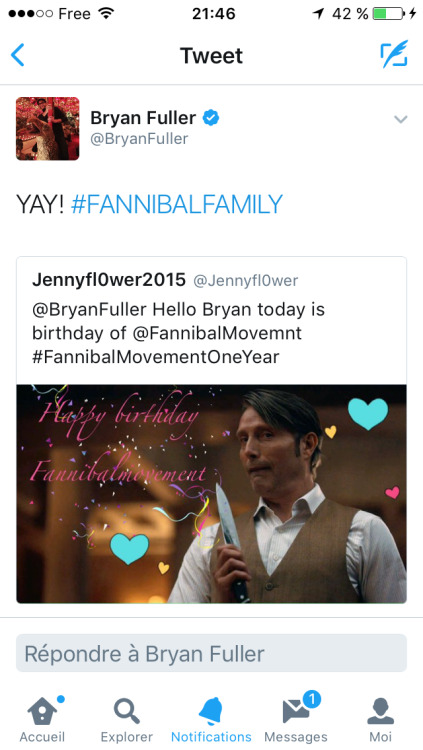
Furthermore, Bryan often retweets fans about their fan-art, text and photo. From the perspective of paratext, it is actually a significant way to show their fans that producers are paying attention to fan’s works and contributions to the show. On the other hand, it is also an encouragement to the fans that the showrunners approved and appreciated the participation of the fandom. What is more, Bryan responds to almost every fan tweets regardless of whether the question is important, entertaining or not. As a matter of fact, by the participation and presence of Bryan on twitter. It seems that he creates a proximity to the fandom, in other words bond to his fans personally.
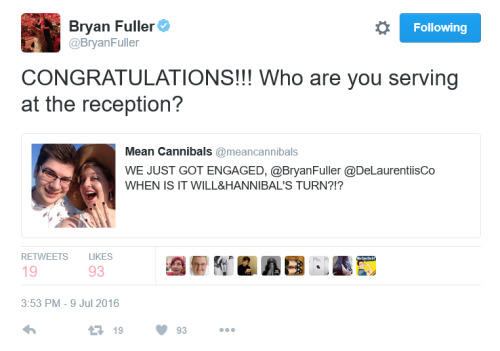
Also, it could advertise the show due to the fact that his actively participation with fandom potentially motivate fans themselves to be more engaged with the show. Then, social media could help to bring up the popularity and raise the curiosity of people who haven’t seen it. Apart from twitter, Hannibal is quite stand out from other fandoms, which it has an official Tumblr site to present the show in a different way. It allows fans to create longer texts including quotes from the show, GIF sets and behind scene photos. Although, it may seem lack of direct contact between producers and fans, “the heavy reblogging of fan-produced content creates a back-and-forth sharing of information” (Segal, 2014).
In fact, this show has a special symbol—flower crown. It first appears on the characters on the show that Photoshops by fans. It seems quite irony due to the fact that the tone of the show is dark and serious. And the Hannibal fandom took it a bit further, it can be seen that the fans, even the producers were wearing the flower crown which made by fans themselves on the comic con as well as on panels. Answering an audience Q-A while putting on a flower may appear incomprehensible to most of people, but it also symbolic of how well the Hannibal producers are treating their fandom and value their input(Baker-Whitelaw,2013).

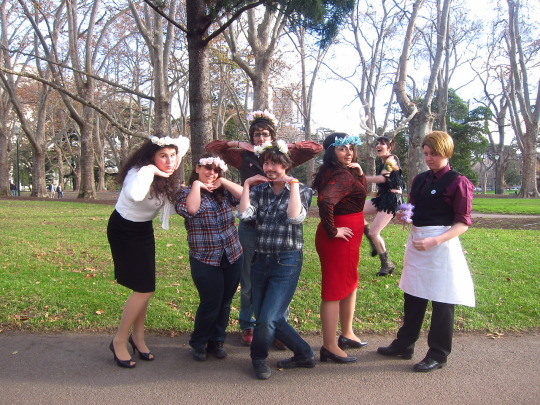
Secondly, shipping is an important element within a fandom. Fans often tweets, making fan art and video about the ship “Hannigram” (Hannibal Lecter/ Will Graham). Fuller, as an openly gay man, didn’t try to deny the implies of the ‘ship’ but to face it and respond to fans. Even more impressively, Fuller and one of the main actors Hugh Dancy fielded the question about ‘slash fan fiction’ with much more understanding than many showrunners who have been attending Comic Cons for a long time. When one of the fans asked about the meaning of the relationship of ‘Hannigram’ pairing, Fuller comments “it brings up an interesting question about ‘what is love’. And love between two characters doesn’t necessarily have to be sexual to still be love. It can still be valid; it can still be powerful” (Segal,2014). Unlike Sherlock, one of the popular shows which taken over the internet, the creator Steven Moffat seems often spoke of his antipathy towards the pairing of ‘Johnlock’ (Sherlock Holmes/ John Watson). The writer seems to have resented the fan’s contribution, and even spent the first episode of forth season that pictured an image of a group of obsessed followers, such as nerd and overweighed woman sit around and investigate how Sherlock managed to survive in the end of season two in order to mocking online shipping phenomenon. However, the executive producer of Fox’s Sleepy Hollow, Mark Goffman seems to struggle with whether he should cater to fans and give them some Easter eggs for them to talk about or just keep the show progress rather than ‘bring one of the character back to life’ just because fans like the character(Segal,2014).
Lastly, it is known that food is the essential part of the show. Therefore, a most unique and surprising production Feeding Hannibal: A Connoisseur’s Cookbookhas made by Janice Poon, the cook of the show itself. It is a collection of easy-to follow recipes inspired by the show and created by its food stylist. It not only has recipes but also the origin illustrations of the food, behind the scene photos of stars and crew on the set of Hannibal. It could be observed that paratext from industry and audience offers a physical connection to the show. As a result, it seems not very surprising that the fans were respond positively and post pictures or tweet about it. On the amazon site, there is 94% of reviews have 5 stars, customers comment the book “a must own for fans of the show and people who like cooking something a bit unique and stylish” (Borders, 2016).

Then, textual poaching is another approach that fans engage with the show. Rayner (2008) argues that audiences are not passive consumers but instead active interpreters. The result can be presented in three fields. The first one is memes, GIF sets and fan-arts which posted on Tumblr. For instance, as it shows below, one of the fan-arts remix Hannibal and Adventure Time, and the two main characters were portrayed similar to the animation of Adventure Time.
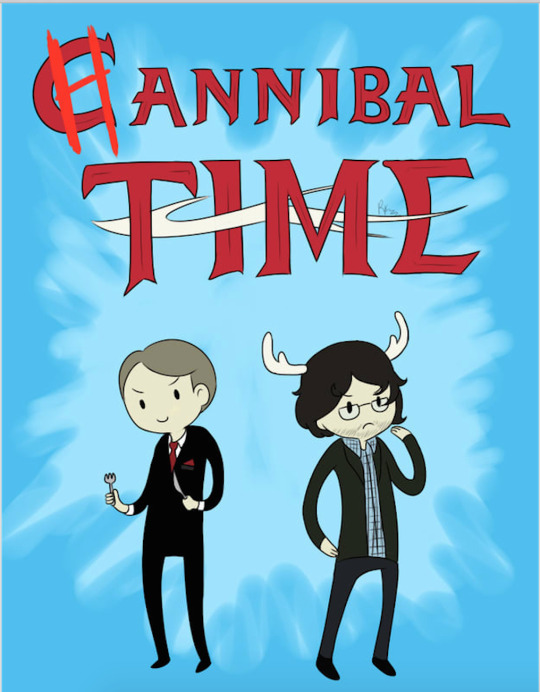
When the Hannibal fandom took over social media, people make memes about this appearance. Using facial expressions of celebrities to match the text which created a dramatic communication with other people. Likewise, when fans began to worry about whether the show has the possibility to be cancelled, since this genre of television show seems rarely to be renewed for second season. A large quantities of memes were emerged on the internet, showing their anxieties about the decision of NBC and express their feelings to the TV network that they would like to see more stories about the character.

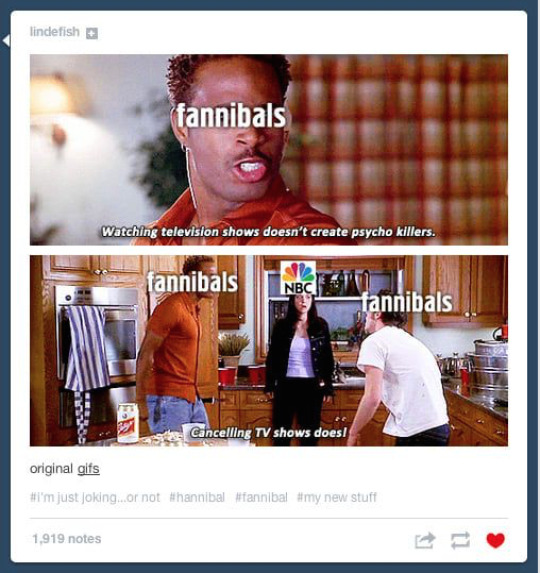
Next, fan videos were made on YouTube as soon as the show started. For example, the series of crack videos (2013) edited scenes from Hannibal with other famous shows quotes, conversations or songs which are quite hilarious. Not only the crack videos bring happiness to the fandom, but also some quality parodies stand out of these fan videos.
youtube
For instance, a parody called ‘If Hannibal were a bad chef’ (2015) made by professional production team CollegeHumor. It teases about the food presentation scenes and characters reactions about it by replace the elegant meal into obvious human organs or body parts. Accordingly, this video got more than 1000,000 viewers and 26,000 likes. The amount of positive reviews informs us whether it is a good or bad production.
youtube
Branston (2010) mentions that paratexts give audiences expectations about what they are going to be seeing and then frame their experiences in consuming that film or show. Since sometimes audience find out that in some scenes when Hannibal almost loudly implied cannibalism to Jack Crawford the head of Behavioral Science Unit at the FBI but he still couldn’t ‘figure it out’. Moreover, Reynolds, a folk singer made a fan song Become the Beast (2015) which inspired by NBC’s Hannibal in order to “explores the close, complex ‘bromance’ Hannibal has with Will Graham and Will’s descent into Hannibal’s dark world” says by Reynolds. The lyrics is actually a true portrayal of the relationship between Will and Hannibal. For instance, some sentences “Does it terrify you or do you feel alive?" “We are the lions, in a world of lambs” is perfectly the spirit of NBC's Hannibal.
youtube
However, at the beginning of 20th century, when the book about Hannibal first showed up, the only way that author connects to his reader was paper material, people tend to write letters for author as communication. As the time passes, movies that based on the novel provides much more paratext among audience, text and industry. For example, trailers were announced to audience in order to give them a glance of how the movie is about. It gives the audience basically what the story is about, where could they watch and who to watch them with.
Reflection
Although I get touch with foreign movies in a young age, China’s domestic features and politics didn’t quite allow audience to think individually and participate with the showrunners. It treated us as ‘mass audience’ and I hardly have any chance to engage with media texts, let alone make contributions to the show itself. In my country, fans were portrayed as a group of young teenagers who obsesses with fine-looking appearance actors and concentrate on digging out any information about the actors. My engagement with the Hannibal TV show, along with other concepts such as participatory culture and paratext, while growing up gave me impressions of what western media system works with audience and further established the problem between producers and fandom. Yet, this extent of communication seems difficult for my country to accomplish within a short period of time. Personally, even while engaging with texts such as Hannibal, I was able to point out things I knew will seems not be able to do especially when I get older. I did not been participate in the media text that I was passionate about and not figure out early enough the way producers respond to fans could potentially motivated them to engage with show more creative and active, or even affect the atmosphere around the show. Through my study of media and research for this essay, I have come to understand the importance of practice of paratext and textual poaching and have made a conscious effort to reshape my perception towards to media text, especially begin to reassess the relationship between individual fans and showrunners, because I understand that the success of a show is when quality social media fans and producers converge.
Conclusion
Even though the rapid development of fandom or the rejection that producers won’t let fans control where the show is head to, the power stills not simply lie on either side audience or author. Hannibal is one of the texts that transformed the concept of cannibalism into food appreciation and psychological thriller which more appealing to more audience thus engaging its fans. These textual poaching cannot be easily recognized as benefit or useless, since some of them have quality content and entertainment at the same time. As a matter of fact, whether it is a contribution or a teaser for the show, it appears to be what showrunners would like to see, people engaging with the show, advertising it on different platforms and eventually would raise the viewers and popularity. Therefore, they could even gain mutual benefit from the project. However, with its addressing of genre and social issues such as the sensitive concept of cannibalism, sexuality and the influence on children, it not only spread information to its audience but also influence people’s outlook who watched the show. Overall, it seems hard for showrunners to find a balance between pleasure the fans and will not make the show deviate from the original script. It largely requires a talent and open-minded creator who understands what’s fans desire but also have ideas about their own show, and the quality fandom which positively engaging with it. Hence, the power of decision didn’t centralize in producers’ hands or fandoms, on the contrary, they cooperate and complete each other. Although Hannibal make a good example about how fandom could actually live peacefully with showrunners, the conflict between two of them is still intense in recent years, it may need time for them to adjust and try to find a way to get along with each other.
Reference:
Andersen, M., 2016. Hannibal's Tasty Paradox. [online] 16:9 filmtidsskrift. Available from: http://www.16-9.dk/2016/01/hannibals-tasty-paradox/ [Accessed 19 Apr. 2017].
Anon, 2013. Hannibal Crackvid #1. [video] Available from: https://www.youtube.com/watch?v=7Lwr4X4_DCY [Accessed 10 Mar. 2017].
Anon, 2015. If Hannibal Were A Bad Chef. [video] Available from: https://www.youtube.com/watch?v=OkGjLch1L2g [Accessed 20 Mar. 2017].
Borders, M., 2016. FEEDING HANNIBAL: A CONNOISSEUR’S COOKBOOK Review. [online] Birth.Movies.Death. Available from: http://birthmoviesdeath.com/2016/10/18/feeding-hannibal-a-connoisseurs-cookbook-review [Accessed 14 May 2017].
Bourdaa, M., 2016. Contemporary participative TV audiences: Identity, authorship and advertising practices between fandom. Master. University of Bordeaux Montaigne, France.
Branston, G. and Stafford, R., 2010. The media student's book. 5th ed. London: Routledge, pp.382-388.
Genette, G., 2001. Paratexts. 1st ed. Cambridge [u.a.]: Cambridge Univ. Press, p.1.
Grant, D., 2014. TV Writers and Showrunners Increasingly ‘Mute’ the Fans. [online] Observer. Available from: http://observer.com/2014/11/tv-writers-and-showrunners-increasingly-mute-the-fans/ [Accessed 5 Apr. 2017].
Jenkins, H., 1992. Textual poachers: Television Fandom and Participatory Culture.London: Routledge.
Kresnicka, S., 2016. Why Understanding Fans is the New Superpower (Guest Column). [online] Variety. Available from: http://variety.com/2016/tv/columns/understanding-fans-superpower-troika-1201743513/ [Accessed 31 Mar. 2017].
Lang, N. and Covucci, D., 2013. "Hannibal" showrunners cater to fandom at Comic-Con | The Daily Dot. [online] The Daily Dot. Available from: https://www.dailydot.com/parsec/fandom/hannibal-comic-con-flower-crown-slash/ [Accessed 30 Apr. 2017].
Macklem, L., 2013. We’re on This Road Together: The Changing Fan/ Producer Relationship in Television as Demonstrated by Supernatural. Master. The University of Western Ontario.
McCracken, A., 2015. Branding Hannibal: When Quality TV Viewers and Social Media Fans Converge. [Blog] Antenna Responses to Media and Culture. Available from: http://blog.commarts.wisc.edu/2015/08/24/branding-hannibal-when-quality-tv-viewers-and-social-media-fans-converge/ [Accessed 22 Apr. 2017].
Reynolds, K., 2015. Become the Beast - A Hannibal Fan Song. [online] Available from: https://www.youtube.com/watch?v=xmVzeriU5m0 [Accessed 2 Apr. 2017].
Sandvoss, C., 2005. One-Dimensional Fan: Toward an Aesthetic of Fan Texts. American Behavioral Scientist, 48 (7), 822-839.
Segal, J., 2014. Hannibal Fandom. [online] Fannibals: TV Fandom & Paratexts. Available from: https://jessicasegalfnms.wordpress.com/hannibal-fandom/ [Accessed 25 Apr. 2017].
Wall, P. and Rayner, P., 2008. AS Media Studies. 3rd ed. London:Routledge, pp.145-148.
Williams, J., 2015. RESEARCHING DIGITAL FANDOM. [Blog] FANDOM, SUB-CULTURES AND CULT MEDIA STUDIES. Available from: https://jackpressfandom.wordpress.com/ [Accessed 5 Apr. 2017].
Williams, R., 2015. Cooking with Hannibal: Food, Fandom & Participation | In Media Res. [online] Mediacommons.futureofthebook.org. Available from: http://mediacommons.futureofthebook.org/imr/2015/09/23/cooking-hannibal-food-fandom-participation [Accessed 7 Apr. 2017].
3 notes
·
View notes